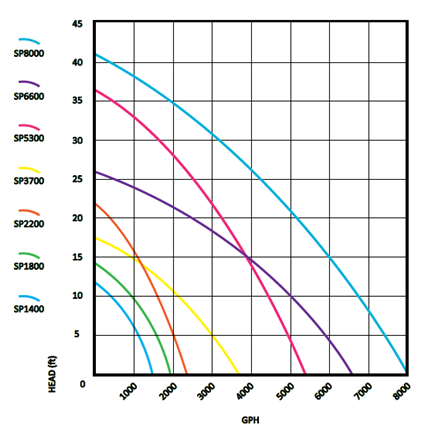Selecting a Pump
Choosing the proper pump will provide you with:
- Pump Longevity
- Pump Efficiency
- Trouble Free Performance
There are a few key elements that you need to know in order to choose the correct pump.
Where Will Your Pump Be?
In the pond at the bottom: look for a solids handling pump (great for pumping waste into filtration units).
In pond (in the skimmer): look for a skimmer/high volume pump (skimmer pumps do not need to handle solids as there is usually a filter basket or net prior to the pump.
Direct drive pump – delivers a large amount of head height. Require a lot of head height (ie: a water feature with falls 20ft or higher).
Asynchronous/Mag drive – high efficiency pump with high volume, but less head height than direct drive. Require volume but minimal head height (ie: most pond applications)
How much volume do you need?
- Light flow = 100 gph per inch of spillway.
- Average flow = 150 gph per inch of spillway.
- High flow = 200 gph per inch of spillway.>
|
Examples for waterfalls with a 36" wide spillway
|
 |
Head Height
Every pump has a chart/graph available to determine at each head height, the amount of gallons outputted. As head height increases gallons outputted decreases. Determining what pump you need according to head height.
- Add 1 ft of head height for every 10 ft of hose you are using;
- Add 1 ft of head height for every 90 degree angle you are using.
|
You have a waterfall that requires 4500 gallons and is 5 ft above the waterline, has 20 ft of hose and utilizes 3 elbows. Therefore, your head height is 5ft (height of waterfall) + 2 ft (hose) + 3 ft (3 elbows) = 10 ft of head height. You will need a pump that pumps out 4500gph at 10 ft which in the above graph would be the SP5300 (Pink Line). |
 |
Back Pressure
The life of any pump is directly related to the operating conditions it works under. One of the most common causes of premature pump failure is low head.
Pumps are designed to work under a certain amount of load. In low head applications not enough back pressure is put on the pump and it spins too freely. This causes the motors to run hot and shortens their life considerably.
In every plumbing system you should incorporate a valve somewhere in the discharge line. This valve can then be closed part way to simulate back pressure if not enough natural pressure is created.








